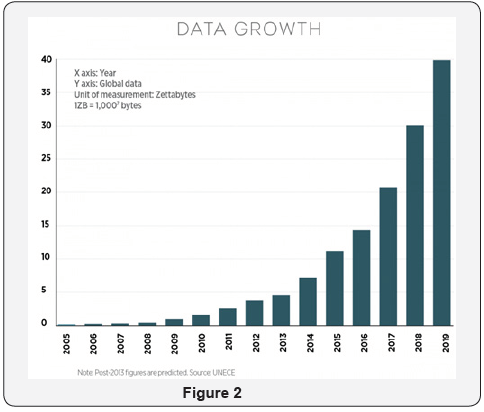Why Should Big Data Analytics Be an Enterprise Wide, Top-Down Approach_Juniper Publishers
Authored by Richard Boire
Mini Review
In order to better understand the theme in the above title, it is important to observe how analytics has evolved very quickly over the last few years. The most significant development, that has altered the analytics landscape, is the ability to consume and analyze much more data such as mobile, social media, and sensor data. This capability was achieved through the adoption of parallel data processing technologies such as Hadoop and its underlying Map Reduce software.
To give you some perspective on these growing data volumes, here are some stats as revealed in Forbes magazine:
I. 1.7 megabytes of information will be created every second by each human being on the planet by the year 2020
II. Data will grow from 4.4 zettabyets today to around 44 zettabytes or 44 trillion gigabytes, a ten fold increase by 2020 (Figure 1).
But what is really driving the focus of Big Data Analytics towards the C-suite? Analytics and data science are not new and data has always been used to solve business problems. However given today’s climate, the old data science approach of “asking for all the data” no longer applies. There is simply too much data that would be irrelevant for a given business problem/challenge. At the same time, many more business problems can now be solved due to access to the larger amounts of data. Organizations, though, recognize that the data itself is no longer the strategic advantage. Instead, the strategic advantage is creating the right information environment to solve the specific business problem/challenge. Data-driven corporate strategies are now the norm which by implication means that the C-suite needs to assume the mantle of leadership in big data analytics. Through this leadership at the top, Big Data and Analytics become embedded in the corporate culture. This fundamental shift towards a much stronger analytics culture has resulted in knowledge of analytics being cross-fertlized throughout different departments of the organization. For example, beyond their technical and mathematics capabilities, data scientists need to have a better understanding or at least the interest in learning more about a given business practice which will be applying their solution. Meanwhile, the business practice people should no longer completely rely on the data scientists for their expertise on data and advanced analytics. The business users don’t need to be able to develop programming code but need to have enough understanding of the nuances of data in being able to solve business problems. At the same time, the business people need to understand advanced analytics at least to the extent of how it might be used to solve a given business problem. They need to interpret results but not necessarily understand the arcane math behind a certain machine learning algorithm (Figure 2).

Analytics practitioners both from the data science area and the business area are in effect becoming hybrids. As hybrids gain this much broader or generalist approach towards analytics, they are in effect become the spokespersons or communicators in how a given analysis was conducted and how it will be applied. But the generation of these hybrids requires C-Suite involvement in creating the right infrastructure and corporate structure. As the industry evolves into higher and more advanced forms of machine learning and in particular AI(artificial initelligence), the demand for hybrids will even be more pronounced. But the key to creating these hybrids will be the continued level of commitment from the C-Suite towards Big Data Analytics (Figure 3).

To Know More About Current Trends in Biomedical Engineering &
Biosciences Please Click on:
https://juniperpublishers.com/ctbeb/index.php

Comments
Post a Comment